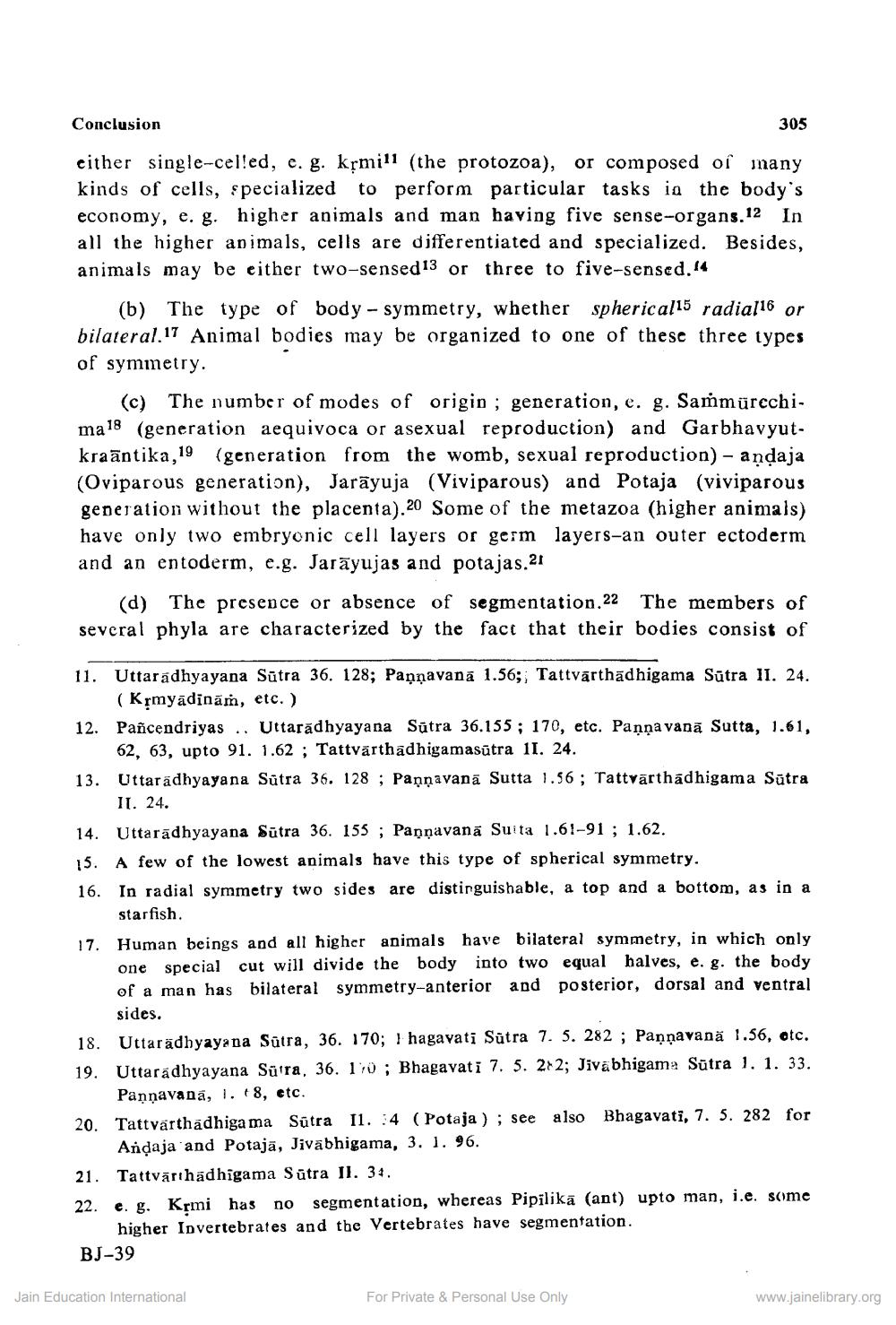________________
Conclusion
305
either single-celled, e. g. kşmi11 (the protozoa), or composed of inany kinds of cells, specialized to perform particular tasks in the body's economy, e. g. higher animals and man having five sense-organs.12 In all the higher animals, cells are differentiated and specialized. Besides, animals may be either two-sensed 13 or three to five-sensed. 14
(b) The type of body - symmetry, whether spherical15 radial16 or bilateral.17 Animal bodies may be organized to one of these three types of symmetry.
(c) The number of modes of origin ; generation, e. g. Sammürcchima18 (generation aequivoca or asexual reproduction) and Garbhavyutkraāntika, 19 (generation from the womb, sexual reproduction) - andaja (Oviparous generation), Jarāyuja (Viviparous) and Potaja (viviparous generation without the placenta).20 Some of the metazoa (higher animals) have only two embryonic cell layers or germ layers-an outer ectoderm and an entoderm, e.g. Jarāyujas and potajas.21
(d) The presence or absence of segmentation.22 The members of several phyla are characterized by the fact that their bodies consist of
17.
11. Uttaradhyayana Sūtra 36. 128; Pannavanā 1.56; Tattvārthadhigama Sūtra II. 24.
(Krmyādinām, etc.) 12. Pañcendriyas.. Uttaradhyayana Sūtra 36.155; 170, etc. Paņņa vanā Sutta, 1.61,
62, 63, upto 91. 1.62 ; Tattvärthadhigamasūtra 11. 24. 13. Uttaradhyayana Sūtra 36. 128 ; Pannavana Sutta 1.56; Tattvārthadhigama Sutra
II. 24. 14. Uttaradhyayana Sūtra 36. 155 ; Pannavanā Suita 1.61-91 ; 1.62. 15. A few of the lowest animals have this type of spherical symmetry. 16. In radial symmetry two sides are distinguishable, a top and a bottom, as in a
starfish. Human beings and all higher animals have bilateral symmetry, in which only one special cut will divide the body into two equal halves, e. g. the body of a man has bilateral symmetry-anterior and posterior, dorsal and ventral
sides. 18. Uttaradhyayana Sūtra, 36. 170; } hagavati Sūtra 7. 5. 282 ; Pannavanā 1.56, otc. 19. Uttaradhyayana Sūtra, 36. 170 ; Bhagavati 7. 5. 22; Jivabhigama Sūtra 1. 1. 33.
Pannavana, 1. 18, etc. 20. Tattvärthādhiga ma Sūtra 11. :4 (Potaja ) ; see also Bhagavati, 7. 5. 282 for
Andaja and Potajā, Jivābhigama, 3. 1. 96. 21. Tattvārthadhigama Sūtra II. 34. 22. e. g. Kľmi has no segmentation, whereas Pipilikā (ant) upto man, i.e. some
higher Invertebrates and the Vertebrates have segmentation. BJ-39
Jain Education International
For Private & Personal Use Only
www.jainelibrary.org




